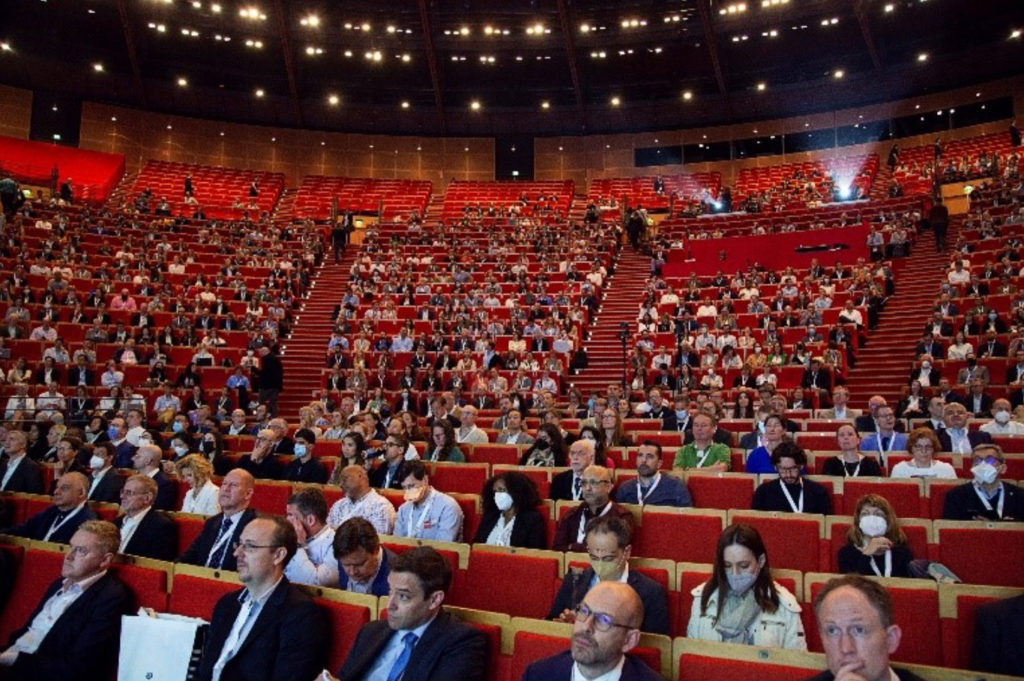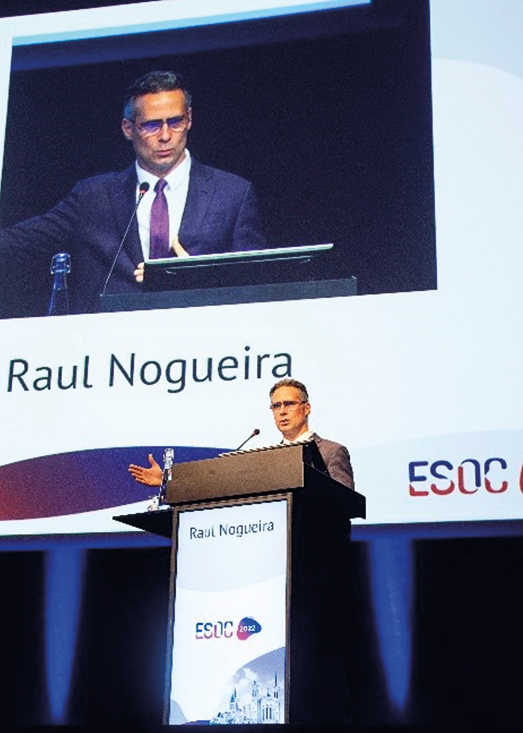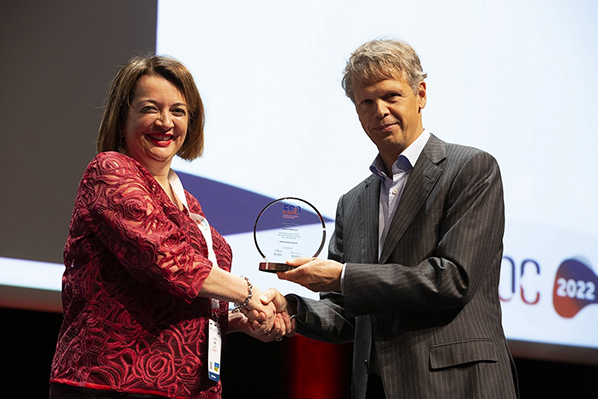After more than a year of virtual meetings and conferences, neurology colleagues from Europe and around the world were finally able to meet up at the European Stroke Organisation Conference, a hybrid meeting online and in the magnificent city of Lyon between the 4th and 6th May 2022.

The conference began with a welcome from Joanna Wardlaw followed by presentation of the results from recently completed large clinical trials. Highlights from this session included Bijoy Menon and Richard Swartz’s presentation of the results of the ACT trial demonstrating non-inferiority of tenecteplase to alteplase and the results of the TASTE-A trial, a first pre-hospital thrombolytic trial. This trial demonstrated the benefit of tenecteplase over alteplase on CT-perfusion lesion size following treatment as well as greater ultra-early clinical improvement. At the end of the session Raul Nogueria presented the results of the ATTENTION trial, finally demonstrating that the overwhelming efficacy of endovascular therapy persists in the posterior circulation leading to improvements in disability and mortality.

The welcome session was followed by a lunch break and then parallel sessions including service organisation, rehabilitation, neurointerventional therapy, cognition and vascular cognitive impairment, risk factors and primary prevention, aetiology and pathophysiology and teaching sessions on thalamic stroke and cerebral hypoperfusion. A session dedicated to levelling up stroke care in Europe including in rural versus urban centres, stroke care for migrants and homeless populations, and care of populations and staff in conflict zones was also included.
Day two started with seven parallel scientific sessions and two teaching sessions covering diverse topics ranging from epidemiology and imaging to covert stroke and the frontline of neurointervention: direct to mothership angiosuite or mothership to patient. Immediately following the coffee break Martin Dichgans (Germany) and Else Sandset (Norway) chaired the second large clinical trials session. Before the presentations of the trials the two ESO award winners were presented, Valeria Caso, Past President of ESO was presented the President’s Award and Guillaume Turc was presented with the ESO Scientific Excellence Award. On completion of the presentation of the Angels Awards to hospitals from ESO countries leading on quality measures the presenters of the large clinical trials took the floor. Christopher Schwarzbach presented the results of the Interstroke Study showing that acute febrile illness is associated with increased odds of ischaemic stroke in most parts of the world and vaccination for influenza associated with decreased odds. The following two talks highlighted atmospheric pollutants and epigenomic age both as risk factors for stroke (Kongbunkiat and Szejko, respectively). Dr Kamtchum then presented their study linking circulating IL-6 levels with higher risk of progression of atherosclerosis and postulating a potential avenue for therapy in those patients not eligible for carotid revascularisation. Rounding off the session, Dr Verhoeven reported the results from the Netherlands of a greater than two-fold increased risk and five times increased risk of cancer diagnosis for younger patients within the first year after ischaemic or haemorrhagic stroke respectively. More work will be needed in order to identify characteristics that might support targeted screening.

The scientific presentations continued after lunch with parallel joint symposia with the European Society of Cardiology exploring the evaluation of cardiac source of stroke and the European Society of Neurosonology and Haemodynamics updating the key aspects in neurosonology. In addition to other symposia including discussions on the role of artificial intelligence and data science in improving stroke care, stroke care in women from pathophysiology to healthcare delivery, reducing waste in stroke research, and the opportunity for teaching on imaging in acute stroke, treatment challenges, management of seizures, and secondary prevention after stroke were available.
On the final day of the conference, the morning was jam-packed with more parallel sessions of stroke science kicking off with a joint symposium with the Pre-hospital Stroke Treatment Organisation putting the spotlight on mobile stroke units and other technologies to enhance the pre-hospital assessment and care of patients with stroke. The morning included discussions on genetics, individualised stroke care and personalised medicine as well as further teaching courses on ischaemic and haemorrhagic stroke. During these parallel sessions the latest ESO guidelines were presented on unruptured aneurysm, secondary prevention, intracranial atherosclerosis, and screening atrial fibrillation in cryptogenic stroke. Before the closing ceremony the onsite television station, ESOC TV reviewed the highlights of the conference beginning with an overview of the work of SAFE in reducing the burden of stroke in Europe by collaboration across the continent, including the not insignificant surprise and challenges of COVID. Colleagues also found the highlights of the meeting being the chance to meet with colleagues, some of whom had only ever been encountered on Zoom, the chance for students and trainees to present in person for the very first time, and the technical success of the online platform as an adjunct to such a successful meeting allowing participation from scientists and clinicians who would otherwise have been unable to attend. We were then encouraged to stay in tune for the final large clinical trials session and look forward to ESOC Munich 2023.
The final large clinical trials session presented a wide range of studies starting with some promising data on adjunctive treatment with Glenzocimab to reduce symptomatic and asymptomatic haemorrhage after reperfusion therapy, though larger trials are needed to confirm efficacy. We next heard from the phase II TEXAIS trial, aiming for better post-stroke glycaemic care but unfortunately a casualty of COVID, stopping early for time constraints. Despite this there is support for the safety of Exenatide after acute ischaemic stroke and a larger clinical trial is planned. Craig Anderson presented insights from further analysis of the ENCHANTED trial which had previously demonstrated reduced chance of symptomatic ICH by intensive blood pressure monitoring after intravenous thrombolysis. The data showed no evidence of increase in infarct volume by early intensive blood pressure lowering in thrombolysed patients. Anna Ramos presented the secondary results of the RACECAT trial. This study of drip-and-ship vs mothership model of treatment showed no evidence of benefit for patients with intracerebral haemorrhage at the expense of a higher rate of transfer complications. Joji Kuramatsu reported the results of an individual patient level data meta-analysis on thrombolytic therapy for intraventricular haemorrhage. Improvements in disability at six months were observed especially in those patients treated within 48 hours. One particularly interesting highlight in this session was the presentation from an international multi-centre cohort study analysing the safety of intravenous thrombolysis in patients taking direct oral anticoagulants. Despite over 40% of included patients being treated with intravenous thrombolysis despite DOAC levels/status not being tested or known, this study offers reassuring safety data. Tenecteplase was reported on again in the TWIST trial assessing the drug vs placebo in patients treated within 4.5 hours after wake-up stroke and no significant difference was found between groups on primary outcome mRS shift analysis at 90 days. The final scientific presentation of the session, day, and conference was the results of the BAOCHE trial, an EVT study from China of patients presenting within 6-24 hours from last seen well and with small to moderate infarct burden on non-contrast CT scan. Although no benefit in mortality was observed, the trial was stopped early due to safety as interim analysis showed a significant benefit of EVT in achieving mRS 0-3 over best medical therapy, further cementing the role of EVT for basilar artery occlusion.
Peter Kelly, the current ESO president closed the meeting with a video review of this ESOC 2022 meeting in Lyon, France. Throughout the conference the presentation of highlights and discussions with experts in the field has been easily available online. ESOC TV was, for me, one of the highlights of the congress as a virtual attender but I, for one, am excited about being able to attend in person for ESOC 2023 in Munich.
